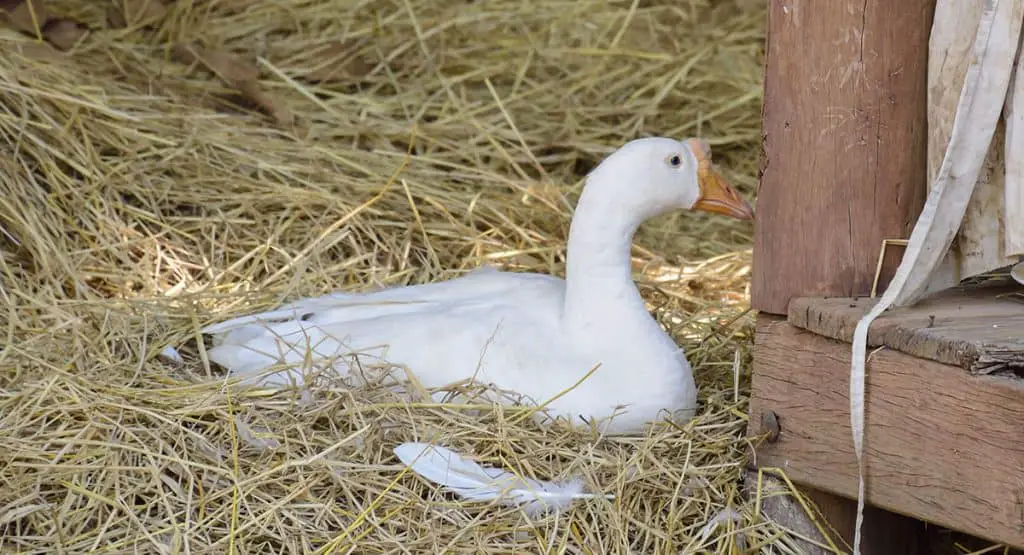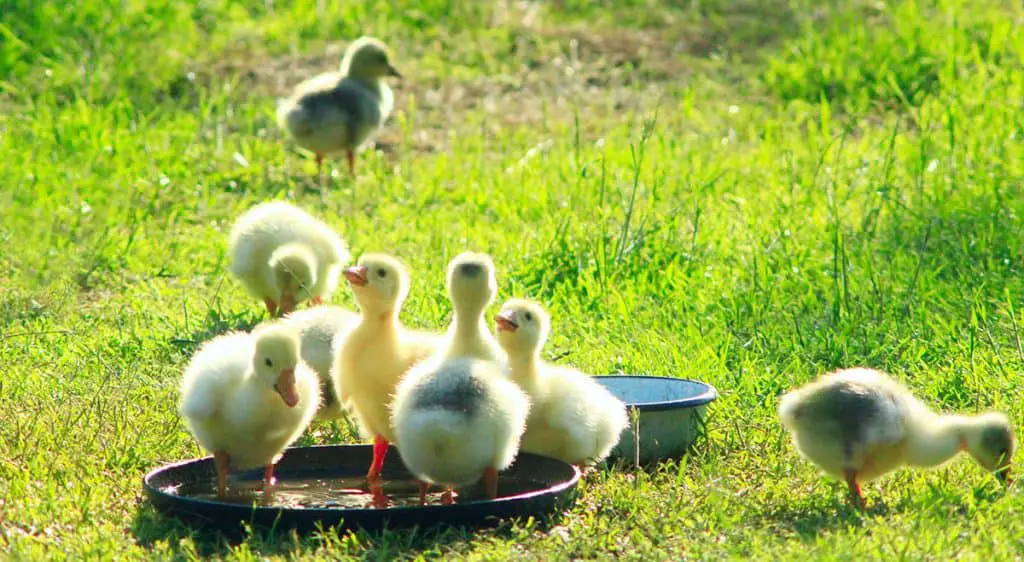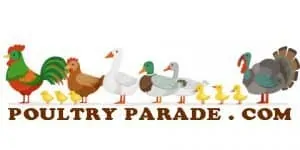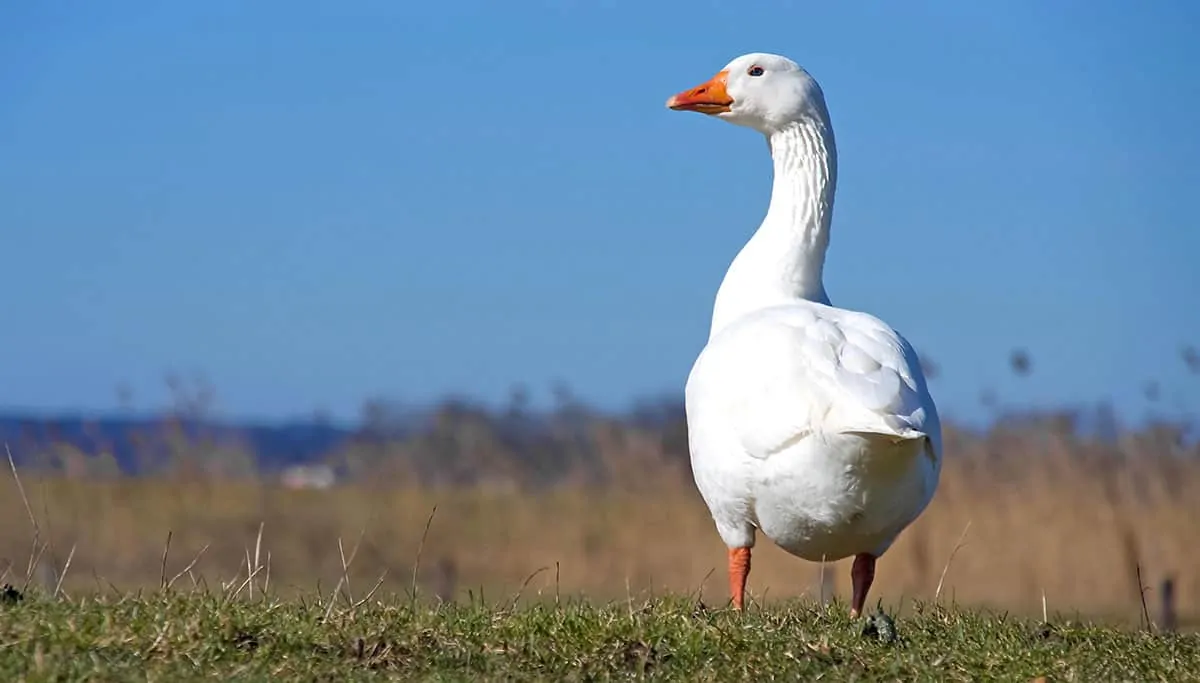If you are planning to get and raise geese in your backyard then this is the guide for you.
If you have kept poultry, chickens, and ducks, in the past, you would be surprised to find how economical geese can be. They are hardy birds, easy to tend, and have fewer needs.
Raising geese can be a bit different from raising chickens so if you have made up your mind, this guide has all the information you need to get started.
There are three main things that you need to know when it comes to keeping geese in your backyard:
- How to provide shelter to geese
- How to feed geese and goslings
- Things to avoid as a keeper
Solid information on these three aspects of geese keeping is all you need to provide your geese with a healthy and comfortable life.
Table of Contents
Shelter for Geese
Geese love to be outdoors but it is necessary to provide them with an equally safe indoor space; an enclosure or a pen.
Indoor Space
There are two major things that you need to keep in mind when designing an indoor space for geese:
- They are ground-based birds
- They have delicate foot webbing
Designing a living space for geese can be a whole lot different from designing one for chickens.
Geese cannot roost, hence, that is something you can mark off the list completely. Since geese stay at ground level, unlike chickens, consequently, you need to organize everything on the ground. The first point on the list should be adequate space.
Space per Bird
Different sources suggest different minimum space requirements per bird, but more is certainly better. There are some sources that recommend providing two square feet per bird, but since geese rest on the ground instead of perches, geese really should have at least six to ten square feet of indoor space per goose.
The main aim should be to keep the geese happy and comfortable in their living space.
Since geese do not roost or jump high, it is crucial that they can enter their indoor space without too much struggle. In case that space is above the ground, putting a ramp on which they can move without falling will help them get inside with ease.
Ensure that the ramp is smooth and cannot harm their feet. A nail sticking out somewhere may damage or tear the webbing in their feet, which will cause pain, and possibly infections.
Keep the enclosure entrance big enough for geese to enter with ease.
When dedicating a living space to geese, it is important to give considerable thought to the flooring since they stay on the floor. There are a few options available for flooring:
Concrete Flooring
One of the floor options is concrete with enough roughness to provide traction.
One significant benifit of concrete flooring is that it is easy to clean, although of course there are cons if everything is not properly done. For instance, geese’s joints may hurt, and they may get bumblefoot or even arthritis.
In any case, concrete will keep any digging predator out of the pen. Put a good layer of bedding on the floor to keep the geese warm and comfortable as well as a softer surface to walk on.
Dirt Flooring
Harder to clean and maintain, dirt flooring alleviates the chances of older geese getting arthritis. It also increases vulnerability to digging predators, but in general, it keeps the geese content.
You can put dirt on a concrete floor to get the best of both worlds but remember to add more dirt as it wears down.
Wood Flooring
This is an option that requires a lot of maintenance as wood is more prone to rot. Additions like anti-skid floor mats are required for wooden flooring as it can be particularly slippery when wet.
Bedding
There are numerous factors to think about before deciding on a bedding option.
Geese require a lot more bedding than chickens. Considering the moisture aspect and geese splashing water, the bedding will also be required to change more often to ensure that it is dry. Mold should be avoided at all costs, at is can cause aspergillosis and other illnesses.
Here is a list of bedding options for geese:
| Bedding | Pros | Cons |
| Straw | Affordable | – Low absorption – Long fibers can tangle in feet – Difficult to change and clean Geese may dig through it |
| Wood Shavings | – Good absorption – Easy to clean – Better if dust is extracted | – More expensive than straw – Sawdust can be harmful for day-old birds (they may eat it) – Cedar shaving can cause respiratory issues |
| Ground Corn Cobs | Very absorbent | May be difficult to find |
| Newspaper | absorbent | – Mushy when wet – Can cause spraddle feet in goslings |
| Peat moss | Ultra-absorbent | – Not eco-friendly |
Since these bedding options have their pros and cons, you can mix different types of beddings to keep the moisture down and prevent geese from digging through.
Also, always ensure that the selected bedding is not harmful to your geese and will decompose once used.
Nesting
Female geese may use the nesting boxes you provide and if they do not like it, they will prefer to build their own nest.
To keep them from making their own nests, you need to put in the effort to make your laying geese like the nesting nook that you are providing. You can build a nest from scratch or use dog houses or pet carriers as nesting boxes as long as it is easy for the goose to get into it.
Nest should be big enough for geese to comfortably sit on the eggs. Ideally, the nest should be 20 by 20 inches and enclosed, as geese are wary of predators. You will also need to provide adequate bedding in the nests to keep the mama geese snug.
If you wish to collect the eggs, leave the first batch of eggs in the nests for a few days to inveigle the geese into continuously lay eggs in the same nests.

Outdoor Space
Geese are water-fowl birds, which means that they like to swim and splash water. A swimming pond will provide them with just that.
Besides swimming, geese like to rest and graze. A shady area where they can rest and dry off after their swimming adventures is good to have. They should be enough wet and dry area available for geese to frolic around without catching diseases.
Your geese should also have a “purpose-built shelter” where they can take refuge from harsh sun, heat, and predators. Try to goose-proof the area by removing any toxic objects or plants that may cause harm.
If you decide to provide enrichment in the form of pool or water trough, make sure that geese can get in and out of it with ease; a platform or a dock will help. Also, make sure that the pools and other open water facilities are kept clean with regular maintenance to keep algae from growing.
Do not give young goslings access to deep water. As an alternative, you can provide them with shallow water troughs.
How to Protect Geese from Predators
Geese are vulnerable to all kinds of predators, hence, predator proofing, both indoor and outdoor living space is mandatory.
Keep geese in a safe indoor space at night. Make sure that indoor space does not have any space or holes for predators to get inside.
Cover any open space with hardware cloth to prevent pesky predators from getting in.
If you have any windows, they should be shut closed. Wooden flooring and walls are more prone to rotting and therefore allow more opportunities for predators. Use galvanized cloth for extra protection, especially, if you have insulated walls. Rats and other rodents are quick to make homes out of insulated walls, but galvanized hardware cloth can prevent this.
When indoors, geese, goslings, and eggs should be protected from weasels, mink, raccoons, badgers, and rats. When outside, geese and goslings should be protected from these predators:
- Foxes, Wolves and Coyotes
- Bears
- Eagles
- Hawks
- Owls
- Snapping Turtles
- Alligators
You should take the necessary measures to keep local predators out including strong and high fencing, as some of these predators are capable of jumping over- or simply going straight through it.
How to Feed Geese
Geese are grazers and will gladly feed on fresh grass during summer. But in colder climates, where grass is not sufficient during winter, wheat and layers pellets should be provided.
Without adequate feed, geese lay fewer eggs or do not lay at all. Geese diet is very similar to that of ducks and it is easy to find commercial feed too.
The dietary needs of geese are simple. They need:
- Protein
- Carbohydrates
- Vitamins
- Niacin
- Calcium
To fulfill all the dietary needs, you can purchase commercial feed from the store. You can either buy all-flock formula or appropriate feed depending on the age. Besides the feed, provide them with pesticide-free grass with insoluble grit.
How to Feed Goslings
Goslings grow up fast, but they require proper care to grow up strong.
Goslings need at least 20% protein and 1% calcium in their diet. During the first four weeks, goslings should be put on a waterfowl starter feed. In case, it is not available, you can use chicken starter, but do not forget to supplement it with niacin (55 mg niacin per kg feed). You can use brewer’s yeast or niacin tablets for that purpose.
You must purchase unmedicated chicken feed. You can also provide gosling with pesticide-free grass clipping. You should also provide insoluble grit (crushed granite) to the goslings if they are not solely fed started feed.
Checklist for feeding goslings:
- Water-fowl starter or unmedicated chicken starter
- Supplement with niacin if using chicken starter
- Do not feed layer food
- Provide insoluble grit
Supplementing Niacin
As mentioned above, goslings will need niacin in their diet. There are two ways to provide niacin:
- Add niacin in water. It is recommended to put around 150 mg niacin in a gallon of water
- You can also use brewer’s yeast. Add 1 to 1.5 cup in 5 lbs. of feed.
How to Feed Adult Geese
At five weeks of age, goslings can rely on grazing if there is enough grass and a good pasture. They also require less protein in their diet which should be around 15% of their diet.
Keep the grass short and fresh for the geese with the help of a mower. Geese tend to like bluegrass, orchard grass, timothy, white clover, and bromegrass and dislike tough grass and alfalfa. Preferably the grass should be no taller than 3 inches.
In case geese do not have access to a good pasture, then they will consume about 7 oz of feed per bird every day.
You can also give them scratch and veggies as a treat. Scratch or grains should not make up more than 10% of their diet as it upset the nutritional balance.
Corn is preferred in winter whereas wheat and oats are great options around the year. In winter, when there is not enough grass to graze, you can add a bit of wheat in water. Once it softens they will happily eat it.
How to feed adult geese:
- Feed a water-fowl diet which comprises of at least 15% protein
- Keep grass less than 3 inches tall
- Plant soft grasses that geese like, for instance, bluegrass and bromegrass
- Provide wheat with pellets in winter when not enough grass is available for grazing
- Provide grains like corn and oats but in moderation
- Provide at least 200mg of feed per bird every day
- Make sure fresh drinking water is always available
Plants that are Toxic to Geese
If your geese have access to pasture and are foraging, you should keep them from getting to certain toxic plants. If you have these plants, remove them from the outdoor space:
- Bleeding Heart
- Buttercup
- Cardinal Flower
- Ivy
- Juniper
- Nettles
- Sorghum Grasses
- Weeping Yew
- Oak
- Mock Orange
- Lupine
- Honeysuckle
- Monkshood
- Morning Glory
If you are unsure about a plant, research before planting or eradicating it to check if it is indeed toxic for your geese.
How to Feed Laying Geese
Geese during breeding season require more calcium in their diet. You should feed them layer feed during breeding season.
Layer feed should not be fed to non-layers. You can also feed black oil sunflower seeds for extra calcium.
How to Give Geese Treats
Besides their daily feed, geese love to get treats. But do not overdo it and give treats in moderations. Fruits and vegetables make great treats so chop some up and make your geese happy.
Here is a list of treat ideas:
| Vegetables | Fruits |
| Cucumber | Apples without seeds |
| Broccoli | Grapes |
| Peas | Watermelon |
| Romaine Lettuce | Bananas |
| Kale | Strawberries |
| Green Peppers | Pumpkin |
| Carrots | Tomatoes |
You can also provide warm corn, cooked beans, and oatmeal as treat.
Don’t feed These Foods to Your Geese
This is a list of food items that should not be fed to the geese as they are toxic:
- Eggplant
- Avocado
- Apple Seeds
- Rhubarb
- Uncooked beans
- Onions
- Chocolate
- Green tomatoes
- Sugary and Salty foods
- Spinach
- Citrus
Weather Care for Geese
Geese are hardy birds and with proper care, they rarely get sick. But you must know how to care for geese in winter and summer and how the care differs according to the season.
Summer Care
In summer, you have to ensure that geese are not forced to live in a hot and uncomfortable space.
Bring down the temperature with the help of fans. In the indoor space, keep the windows open and prevent the predators from getting in with the help of hardware cloth and other barriers.
Similarly, keep the door open if possible and safe. Exhaust fans without added protections are not recommended as vermin can get inside through the holes. You can also use a cooling system.
Outdoors, provide them with enough places to rest and take refuge from the sun. This can be in the form of sheds and trees; just a shady space where they can rest.
Winter Care
Provide your geese with a good and fluffy bedding in winter. In case of rains and cold spells, keep them inside the pen. If it is cold, provide a good heat source.
You can install floor heating or provide heat panels. Do not use anything that can be a fire hazard. Also, provide them with enough ventilation as it may get pretty humid inside.
Keep their water from freezing with the help of a heated bowl. Do not keep any heated bowl plugged in overnight as it is a fire risk. In winter, do not let your geese take a dive in ponds that may be frozen.
Maintenance for Geese Keepers
Keeping geese just like keeping chickens require daily, weekly, and monthly maintenance. It is a good idea to have a checklist and keep remainder notes for maintenance. This maintenance also includes cleaning as geese tend to be messy.
Daily Maintenance
Daily maintenance mostly involves checking that things are alright in the geese’s indoor and outdoor living space. Here is a checklist that will make your daily maintenance easy.
- Check and turn bedding. (Check it thoroughly because it can be damp underneath)
- Check for any holes in the enclosure
- Check the swimming area. (ponds, pools, etc.) to ensure they are clean
- Check drinking water (provide fresh and clean water at all times)
- Check nesting areas (remove broken eggs, collect eggs, add fresh bedding)
- Clean any messy and wet area
- Check outdoor fencing for any breaches
Weekly Maintenance
Weekly maintenance depends solely on the responsibilities that you keep for the week. You can make your own checklist that should mainly include cleaning the space for geese, changing bedding, changing bedding in nests, cleaning floors and walls, and swimming pond maintenance.
Besides that, you can choose to thoroughly clean the feeder and waterers. Checking any cooling or heating systems that you have installed is also a good idea. Make sure you wear masks and gloves when cleaning the space.
Health Check for Geese
Weekly and daily maintenance of the enclosure and surroundings contribute to keeping the geese healthy and happy, but it is also important to monitor the geese. Checking geese for any signs of illness will enable you to intervene early on.
One of the main symptoms of illness or injury a goose is if they are isolated from the flock and hiding. There are also physical symptoms to look for like discharge from eyes, open mouth, limping, labored breathing. A sick goose may have droopy wings and be less alert. Lack of appetite and abnormal stool also point to illness.
If you catch any signs of illness in your geese, intervention is required. Here is a checklist to make the daily checkup easy for you.
Checklist for Health Check
- Eyes: Check for watery, crusty eyes or unalert eyes.
- Bill: Check for open bill, hot bill, and drooling
- Nares: Discharge from nares, bloody nares
- Feet: Check for swelling, injury, lumps, discoloration, and bulge
- Legs: Check for mites, cuts, lumps, and inflammation
- Feathers: Check for missing, broken, untidy, bleeding feathers
- Skin: Check for mites, cuts, lumps, parasites, color changes (blackened, Red) in skin
- Body Weight: Check for noticeable weight gain or loss
- Droppings: Check for strong smell, bloody, yellow, bright green, foamy droppings
Enriching Your Geese’s Lives
Providing a safe and secure outdoor and indoor space, providing plenty of feed, and doing regular health checkups is necessary. But in order to make your geese content, it is important to provide them with something to do that will be fun and enriching, particularly in winters when they stay indoors.
Here is how you can improve your geese lives by planning weekly or daily activities.
- Engage geese by providing them with opportunities to forage by planting geese-friendly herbs and plants and providing them with forage boxes
- Provide them with whole cabbage head to peck it throughout the day
- Make small toys with strings and chopped vegetables
- Add big colorful balls in their feeders to give them something to pay attention to
- Put sticks and safe toys in the enclosure
You can get as creative as you want but make sure that all the activities are safe for the geese. Do not add anything that they can swallow leading to a blockage.
How to Care for Goslings

Gosling care is a bit different from caring for mature geese, because goslings need extra protection and warmth. You will need a brooder that is kept in an area that is protected from predators.
Do not put goslings in wired-bottom cages as it can hurt their delicate feet webbing. You can make your own brooder out of pet crates and brooder lamps.
Here is a chart for the space required by goslings based on age:
| Age | Minimum Space per Bird |
| 3 weeks | 1.5 sq. ft. |
| 4 to 8 weeks | 4.5 sq. ft. |
| 9 to 17 weeks | 6 sq. ft. |
Brooders can have concrete, dirt, or wooden flooring, but it’s important to add proper bedding inside.
A mix of straw and wood-shaving can be used as bedding. Do not use newspapers, as it can cause spraddle feet.
To keep them warm you can purchase a brooder heating plate or a heat lamp. I recommend the heating plates, but if you decide to use a heat lamp, place it at least 18 inches away from brooder walls, as it is a fire hazard.
You should start with a temperature of 95o F and reduce it by five degrees every week till they grow their feathers.
Goslings dropping can be wet, so make sure that you are keeping the bedding dry.
Goslings may swallow or eat the bedding so make sure you are using bedding big enough that they cannot eat. Avoid sawdust bedding because they may will try to eat it.
Goslings require a waterer in the brooder. They should not be able to get inside the drinking water, but there should be enough water for them to dip their heads in it. Change their drinking water regularly.
For swimming, you can provide few weeks old goslings with a small water trough, but do not give them access to deep waters.
Do not let gosling unattended when outside; goslings are easy prey for small and big predators hence all the outings should be supervised.
Summary
Geese are great to keep as they are (usually) friendly and easy to keep.
They do not require any fancy structure in their enclosure; simple nesting boxed with bedding and enough space to keep them safe and comfortable is all they need.
With good pasture, you can cut down on their feed which makes them very economical.
They are easy to look after and just a delight to watch. Their average life span is around 25 years and they should be kept in pair or a flock as they are social birds.
Use this guide to care for goslings and geese, keep their living space clean and dry, and check the geese and their surroundings to detect any issues early on.
Keep them healthy and thriving with proper feed, enrichment, and treats. May you geese live a long and happy life!


